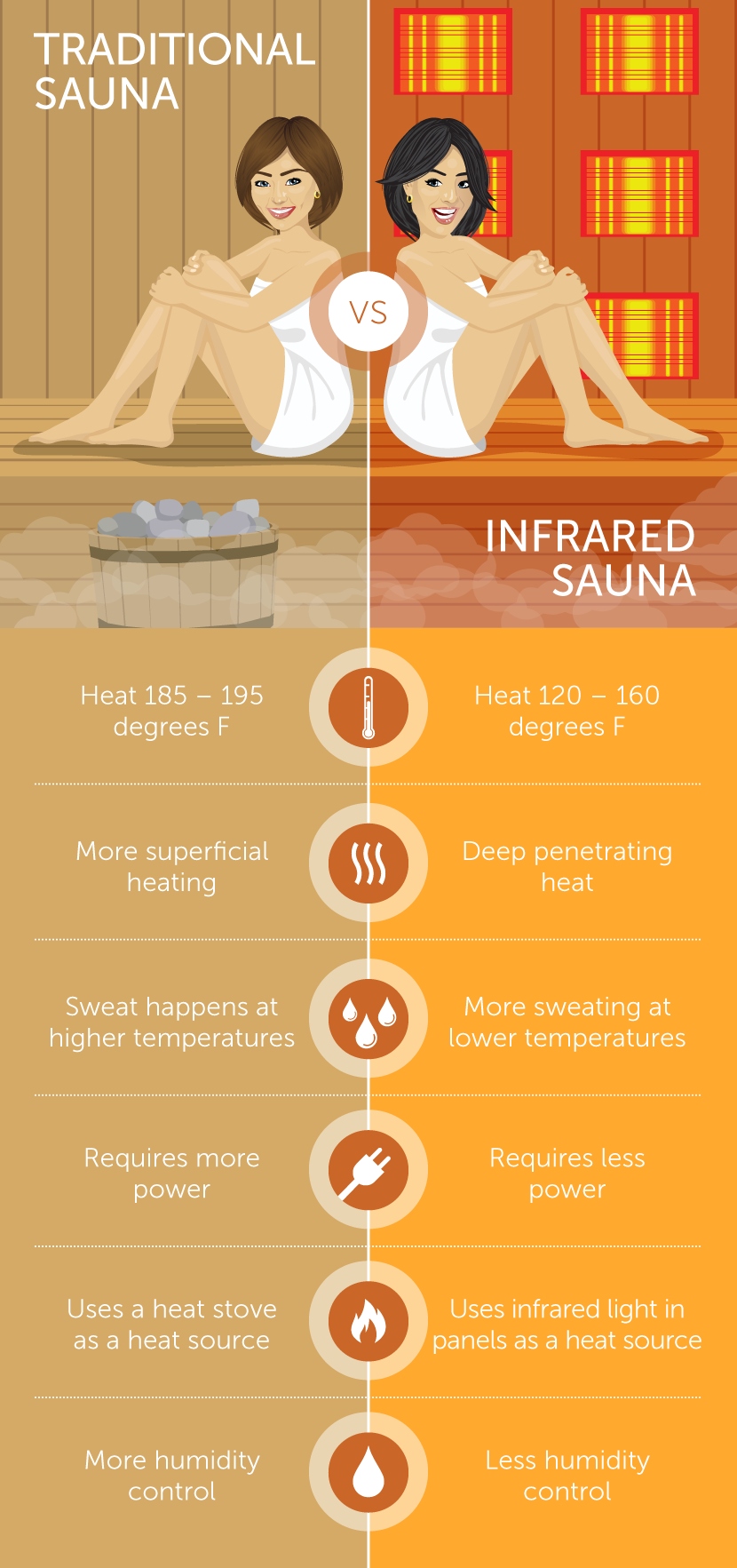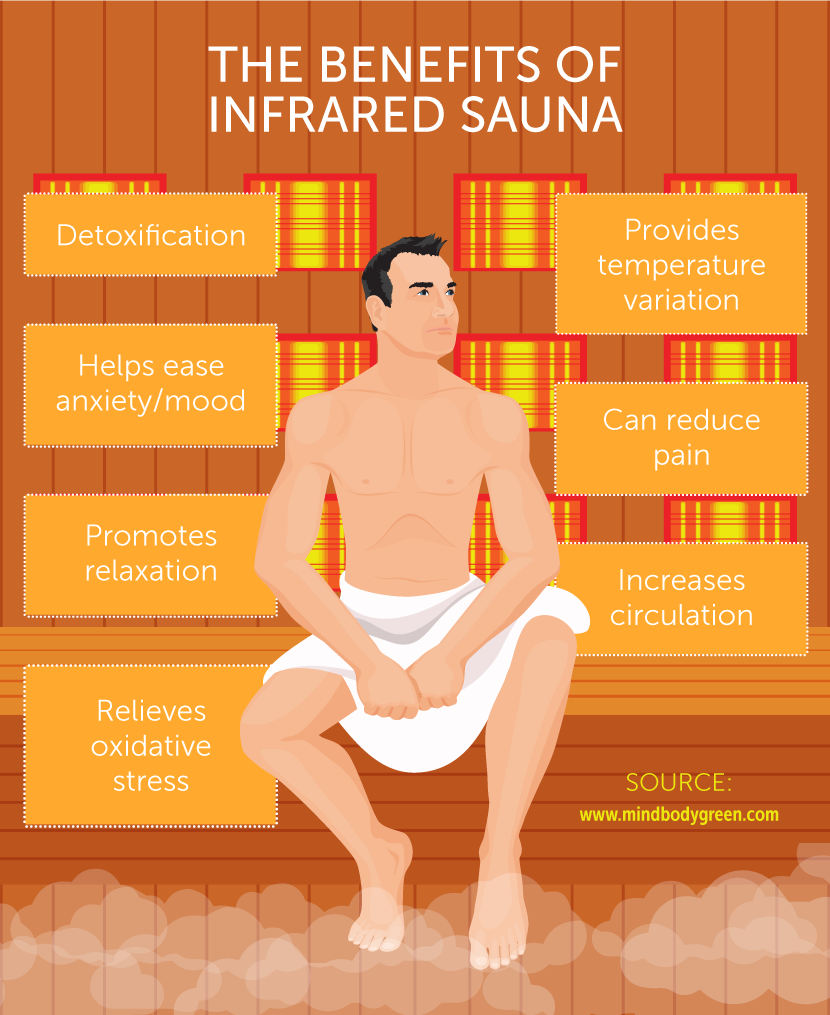Infrared Sauna Benefits
In the seventies, when I was about nine, my family owned a ski condo. The best part of that ski condo was the enormous sauna they had in the common room downstairs. Every night after skiing, all the parents would trudge downstairs in their towels and bathing suits to sweat off their sore knees and muscles from a long day of skiing. I loved it. I loved the social nature of sauna culture and the ritual of running out into the snow to cool off. I recall, even at that age, I slept more soundly and just had an intuitive sense of feeling better after I had a sauna session.
Sauna is one of the few health practices that crosses dozens of cultures. According to Mark Sisson in his article, “Why Some Like It Hot,” Greeks, Romans, Eskimos, indigenous peoples of North America and Central America, Finnish, Russians, Turkish, Japanese, and Koreans all had their own version of sweat therapy and have been performing it for hundreds of years. But of late, infrared sauna options seem to have overtaken the traditional sauna concept.
The first infrared sauna was invented in Japan in about 1965, but sauna-type buildings, huts, tents, or even holes in the ground, date back over two thousand years.http://rockymountainsaunas.com/infrared-sauna-history/

So, why has infrared (IR) sauna become so popular? Is IR the health hack so many are talking about?
I remember being invited into my first infrared sauna about 20 years ago at my sister’s house. (She always has the coolest stuff first.) At first, I shunned the tiny box built for one, having been so enamored with the ski sauna experience of my childhood. But she convinced me, and I was an immediate convert. The increased sweating but decreased discomfort from the heat convinced me. I loved the clean look and the easy operation and the consistent temperature that traditional saunas cannot offer. But I wondered, what are the practical differences between them?
Traditional sauna has a small stove inside that heats the room. On top of the stove are rocks that can be sprinkled with water to produce steam. This means that the humidity in a traditional sauna can vary, unlike the infrared option. Both saunas are built to get you sweating, but the infrared sauna is a more deeply penetrating heat and can have a person producing sweat at much lower temperatures. The traditional sauna typically ranges from 185-195 degrees Fahrenheit, whereas the infrared temperature ranges from 120-160 degrees Fahrenheit.https://www.mindbodygreen.com/0-12265/6-benefits-of-infrared-sauna-therapy.html The traditional sauna heats from one end of the room, where the stove is located, whereas the infrared sauna is equipped with panels throughout the space to create a more consistent heat experience.

So, what are the benefits of infrared sauna? If you peruse the websites of infrared sauna manufacturers, you will find claims that infrared saunas will do everything from helping you lose all that pesky weight to aiding in curing insomnia and cancer. But what claims have some scientific backing? If you dig through the research (it appears that there are more research studies on the benefits of infrared as opposed to traditional sauna), there is substantial support for hopping in that sauna on a regular basis. Here are a few of the key benefits.
Detoxification
Sweating has always been touted as a tremendous method of detoxification. Infrared sauna causes you to heat from the inside out which means sweating begins at a lower temperature and is typically more profuse than results from traditional sauna.http://articles.mercola.com/sites/articles/archive/2012/03/21/dr-clement-on-detoxification.aspx We already know that the body detoxifies naturally quite well through the skin and about the filtration functions of the liver – increased sweating may allow those systems to operate even more optimally.
Temperature Variation
With the movement toward “Ancestral Living” and “getting back to our roots to get healthy,” one of the things experts have observed is that when our bodies go through significant temperature changes, there are associated health benefits. Certain hormone dumps and responses by our immune system only occur when the body is forced into temperature regulation. Today we live in a temperature-stable world. When we go from home to car to work to car to home, we experience less than five to ten degrees difference in temperature. Cold and heat therapy are becoming very popular because we know of the benefits temperature fluctuation can bring to our physiological systems.http://biohackersummit.com/2016/10/15/dr-rhonda-patrick-health-benefits-of-sauna/
Anxiety/Mood
IR sauna has been shown to be helpful for alleviating anxiety and depression, which may have to do with sauna’s impact on increasing B-endorphins.https://www.ncbi.nlm.nih.gov/pubmed/25740582
Pain
Pain reduction is probably one of the most well-studied benefits of infrared sauna. Think of the opportunities to reduce intake of pain medication – resulting in further detoxifiction – if sauna can produce a consistent reduction in noticeable pain! Other studies are showing positive impacts on chronic fatigue, fibromyalgia, and certain arthritides like Sjogren’s.http://universityhealthnews.com/daily/energy/new-study-shows-infrared-sauna-benefits-patients-with-chronic-fatigue-syndrome/
Relaxation
It goes without saying that a few minutes in a sauna brings it “down a notch.” The heat helps muscles to let go and and tension to dissipate, and the overall feeling of wellness that sauna produces is well-known. A forced 30-minute time out is a wonderful way to take a tech/work/stress break that will prompt a “thank you” response by our bodies.
Increased Circulation
Probably the second most-studied effect of infrared sauna is in cardiac patients. A decrease in blood pressure and improvements in circulation are just two of the benefits noted in studies.http://www.jnhlifestyles.com/health-benefits-of-using-infrared-sauna-cardiovascular-health/
Relieves Oxidative Stress
Oxidative stress is the relative inability of our bodies to detoxify at a rate that is consistent with their exposure to toxins. When we are under oxidative stress, disease conditions like autoimmune disorders, cancer, and metabolic disease are much more likely to occur. Oxidative stress also contributes to the general process of aging. Wrinkles, gray hair, and slowed metabolism are all signs of oxidative stress. Several studies show that infrared sauna can slow the impact of oxidative stress on our bodies.https://selfhacked.com/2016/05/08/reasons-sweating-far-often/ http://www.marksdailyapple.com/why-some-like-it-hot/
So now perhaps you have decided that infrared sauna would be a complement to your goals for healthy living. It is important to ensure you are doing your sauna therapy in a way that allows you to get the most out of the experience:
- Start your session when the cabin temperature is at 80-90° and let your body warm up the rest of the way as the sauna warms up.
- Start slowly! Twenty minutes maximum for the first few sessions.
- Make sure you hydrate before and after your sauna.
- Do not allow yourself to overheat. If you feel lightheaded or queasy, crack the door open or exit the sauna and lie down for a few minutes.
- Increase in heartbeat is normal, commonly up to 30%.
- Lay towels underneath you to absorb the sweat.
- Be sure to allow your body to cool to room temperature in a relaxed position after completing your sauna session.
- Take a shower after your sauna is completed. (Rinse those toxins!)
- Sauna is suitable for most people but if you have diabetes, circulatory issues, cancer, or another condition, be sure to consult your doctor before beginning your sauna practice.

Most people try out an infrared sauna at a gym or spa, but the health benefits seem to be greatest if sauna is used multiple times a week. So, having one in your home makes sense if you are going use it regularly. The good news is that purchasing a sauna for your home can be affordable. You can get a single-person infrared sauna for about $1,500. They take up hardly any space and can fit easily in a corner. Infrared sauna requires less power than traditional sauna. There are criteria to consider before buying. Not all saunas are created equal, and there are a lot of manufacturers hitting the market with sub-par products because infrared sauna is becoming so popular. Here are the most important features:
Wood Type
The wood that your sauna is constructed from is an extremely important consideration. The aim of infrared sauna is detoxification. The literature conflicts about detoxification, but think about heating low-grade or treated wood and the chemicals that might be release into the sauna that you would inhale. It seems the most desirable woods are the Canadian or Western red cedar and hemlock. Other woods used in sauna construction are basswood, eucalyptus, aspen poplar, and California redwood. My recommendation is to discuss any concerns you may have about wood toxicity with your sauna dealer, and make a personal decision based on your needs and sensitivities.
Lights
There are many saunas that come with colored lights. There is research that might suggest exposure to certain colors of lights can have particular effects on your health. If nothing else, rotating lights look super cool inside a sauna.
Music
You will need to decide if having or not having music is important to you. I like a peaceful playlist while in a sauna, but some want silence. Most saunas at this point come with a built-in music option.
Removable Bench
Stretching or performing yoga under infrared lighting is therapeutic. You may want to consider purchasing a sauna with a removable bench so you can create stretching space.
Size
You can go very tiny with an infrared sauna, but you should consider whether you will ever want more than one person in there. I like to shift my position a lot, and like a little room to move, but of course the price point increases with size.
Customer Service and Warranty
Infrared saunas are simple to purchase, set up, and use. But things like wood warping and mechanical issues can happen, and you want to be protected. Make sure your sauna comes with excellent customer service and a broadly encompassing warranty.
Electromagnetic Field Exposure
Here is what we know: too much exposure to electromagnetic field (EMF) can be disruptive to sensitive processes in our body. When you sit in a little sauna box with a high exposure to EMF, you cannot move away from its source. If the purpose of sauna is detoxification, being surrounded by disruptive EMF forces may be very counterproductive. Therefore, it is important to buy from a manufacturer that acknowledges and addresses the EMF concerns about infrared sauna.http://articles.mercola.com/sites/articles/archive/2012/04/22/steve-benda-on-saunas-and-emf.aspx Manufacturers should install heaters that are low to no EMF and the entire sauna should be tested for EMF leakage before it is packaged and shipped.
Embed the article on your site

